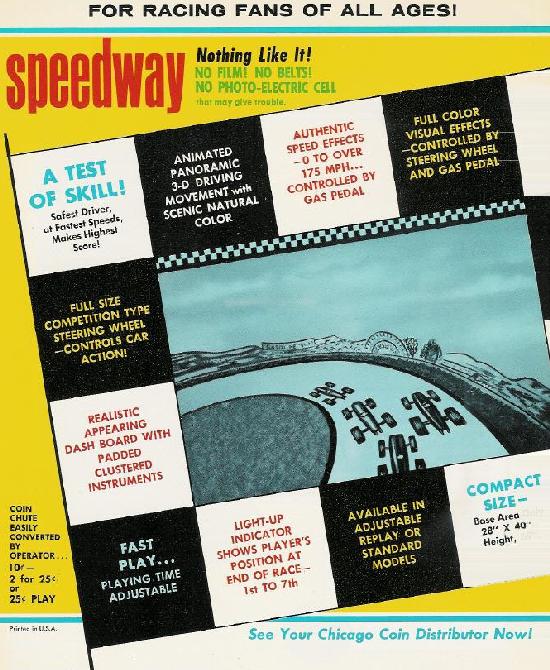
|
Description: Speedway, Chicago Coin, 9/69, electronic sounds (small amplifier and mechanical devices that produce sound). Also made as CCM Mark III (though I don't know if there were any differences between Speedway and MarkIII). Speedway is essentially the same exact game as the year later CCM Motorcycle (1970 and 1974), but with a race car theme versus a motorcycle theme. The 1969 CCM Speedway and 1970 CCM Motorcyle have sound, but no "accident" sound (unlike the year 1974 CCM Motocycle, which has an ambulance siren sound when the driver crashes.) The Speedway used two mechanical sound generators, one with essentially a photograph needle to pick up the mechanical sounds. The car sound is generated by a relay coil and magnet. Then an amplifier with both volume and tone controls feed the sounds to a speaker. The actual race cars and track are on several clear discs with motors running at different speeds. This gives a nice illusion of racing (all left turns!) at something like an Indy car track. This game does not use any films or other parts that quickly deteriorate. This means that the CCM Speedway was a good running game, requiring little to no maintenance for the operator. Another reason this game was quite popular, and often seen in arcades during the 1970s. It was hard to kill this game, and operators made a lot of money running it. Note that Chicago Coin Speedway has two different cabinet styles. The earlier style, known as "Model A", is blue-ish in color. The later cabinet is white (known as "Model B".) Also the later Speedway cabinet has a metal box around the gas pedal, probably to protect it from player kick damage. And yes the schematics between the two models are slightly different (the Model B schematics are indicated as such, where the Model A schematics have no notation.) This game was insanely popular. It was really the first EM arcade driving game that seemed somewhat realistic. Prior games used a small manikin car or other similar ideas, and frankly did not feel like real driving. The Speedway (and later Motorcycle) felt much more like an actual driving simulator. This game and the later Motorcycle were so popular that Chicago Coin just kept making them... two cabinet styles for both Speedway and Motorcyle, from 1969 to 1974. But by 1975 video style games were released, making EM arcade driving games instantly obsolete. Speedway is also similar to 1969 Kasco Indy 500 and 1969 CCM Drive Master and 1969 Sega Grand Prix and 1970 CCM Speed King. But CCM Speedway outsold all those other games by a huge margin. A couple years later Chicago Coin released a "Super Speedway", which was basically the same CCM Seedway game, but with upgraded sound. Instead of the phonograph needle used to generate the car crash sound, Super Speedway has a solid state sound generator and amp board. Super speedway also uses the speed control disc from the 1974 CCM Motorcycle game.
The Speedway Sounds. Note another common problem with either sound on the Speedway is the RCA jack cable going from the sound maker to the amplifier. The common ailment is the shielded ground wire breaks. Note these two cables have three wires (green, orange, ground shield), but only the green and ground shielding is used. The orange wire is not connected. It's best to check these wires with a DMM to make sure they are connected and not broken. The car motor sound is pretty reliable, and generally works well. The car crash sound however rarely works. The photograph needle is fragile, and must touch the piece of 4"x4" copper, which is struck by (essentially) a knocker coil. There's only so many hits that copper will take before it damages the photograph needle. A new needle can be installed, but usually most people just forget that the car crash sound is even present. This is largely because of the super loud "bang bang bang" steering wheel recoil sound during an accident drowns out the crash sound. The steering wheel recoil frankly makes the actual car crash sound seem, well, unimportant, and barely audible. Therefore a missing car crash sound is often ignored and not noticed. I have tried replacing the photograph needle with a more modern replacement, without great success. Amazon sells some inexpensive stereo record cartridges that will work, but it's just not loud enough (even with both right and left cartridge channels tied together.) Therefore I have abandoned the original car crash sound, and gone with an MP3 replacement. It's a lot better and far more audible. And it's a bit more fun too, as we can add to the sound, since it's a MP3 file.
Adding the Crash and Ambulance Siren Sound. To make this modification, I used a Williams relay with a single switch. Wired the new relay in parallel to the "accident" relay currently in the game. Yes i could have added an additional switch to the existing Accident relay, but frankly, there's just not enough physical room. So for me it was just easier to parallel a second relay to the Accident relay. The one switch on the added relay turns on 6vac GI power from the transformer (blue) to a bridge rectifier (with a 2200mfd cap across the +/- leads of the bridge.) The transformer center tap (green) is used for the other AC lug of the bridge. Then the DC power from the bridge rectifier goes to the MP3 board. When an accident happens in the game, the "Accident" relay and the added relay pulls in, and the MP3 board powers on, automatically playing the recorded MP3 ambulance crash siren sound. There's a picture of this set up below... The MP3 player I am using is a DY-SV17F type, similar to this very inexpensive Amazon MP3 player that costs about $5. It has built-in 4mb RAM, enough to hold the above linked ambulance MP3 crash siren file (no microSD card is needed.) You need to set this device to "I/O Independent Mode 0", which means Con2 pin must be permanently grounded. Then Tx/io0 pin is permanently grounded, so upon power on, the file 00001.mp3 (the ambulance crash sound) plays. The v5 and Gnd pads go to the bridge recitifier (with interuptable power from the added relay and switch.) And obviously the speaker pads go to a speaker. Note you must use a separate speaker for the MP3 board. And do not try and use the existing Speedway sound amp on the MP3 board (you will destroy the MP3 board.) With this modification, when the stock Accident relay energizes, the added paralleled relay also energizes, and closed the power path switch to the bridge rectifier. This in turn supplies about 6vdc to the MP3 board, which immediately plays the recorded Ambulance crash siren sound. So for very little money and effort, the CCM Speedway game gets a nice sound upgrade, to match the 1974 CCM Motorcyle cousin game. The crash and ambulance sound is really a nice touch, and makes a crash (accident) seem more, well, serious! If you have a Chicago Coin Speedway for sale, please contact me at cfh@provide.net
|
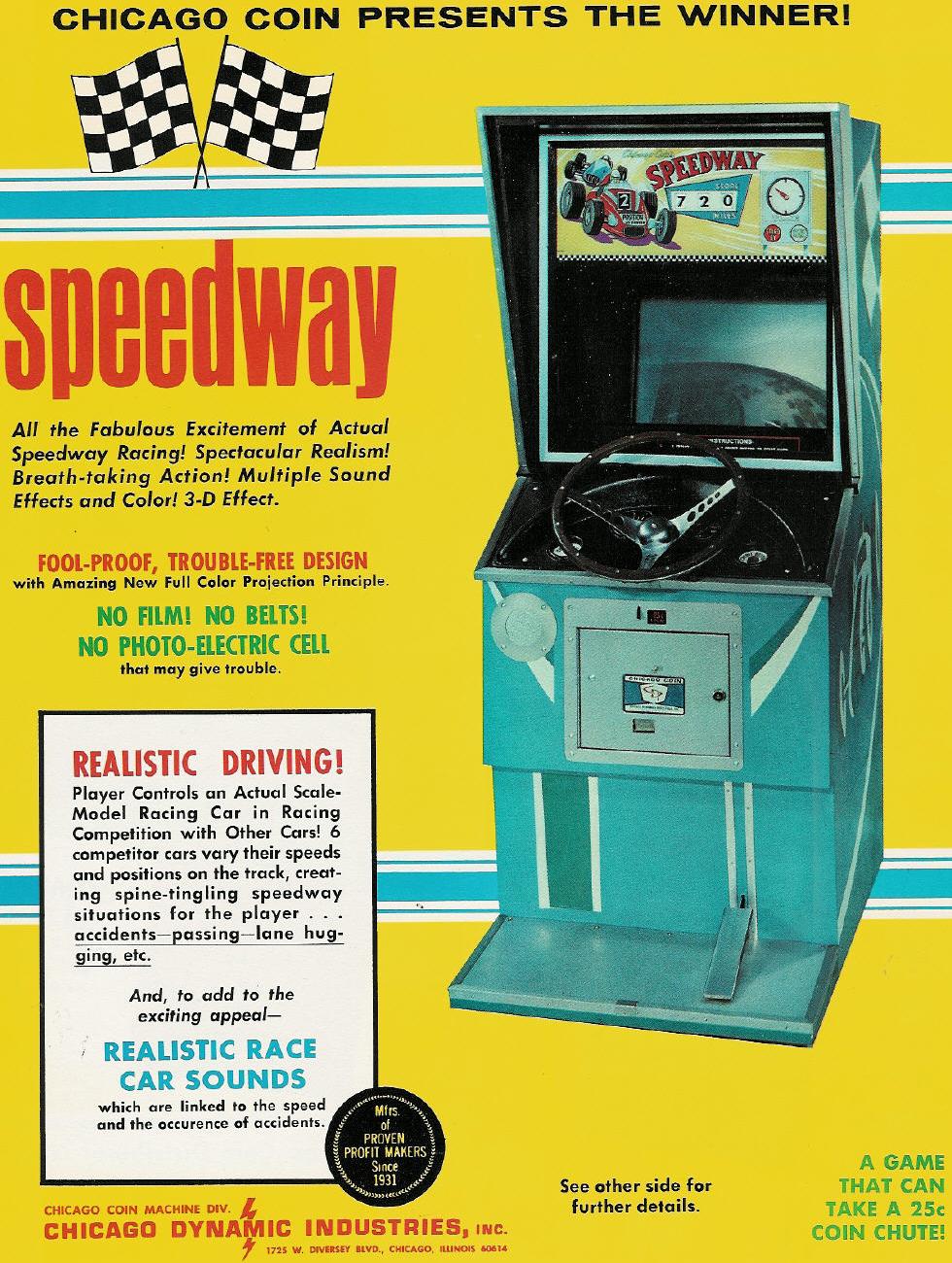

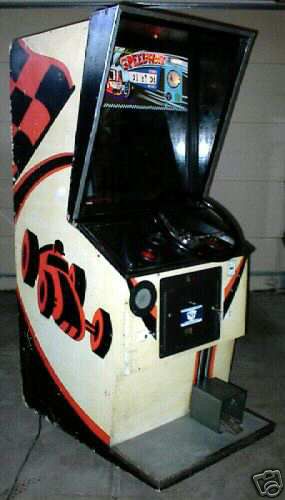
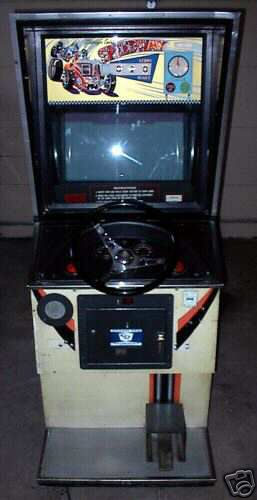
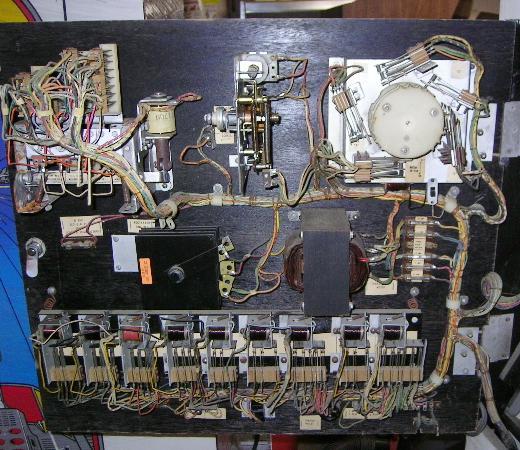
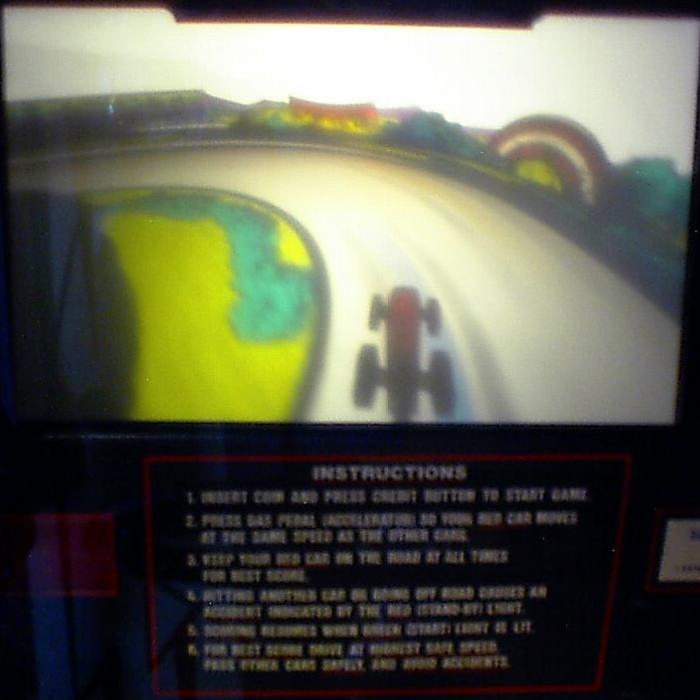
Here's the bottom panel of Speedway. Notice the box on the
left side of the panel. This has a sensor which reads the
large black motor in the center. The motor is DC, and changes
speed as the driver's car goes faster. The box reads this
speed and makes electronic sound based on the speed of the motor.
Compare this to the electronics uses to do the same thing in the
1974 CCM Motorcycle, which embraced fully electronic sound.
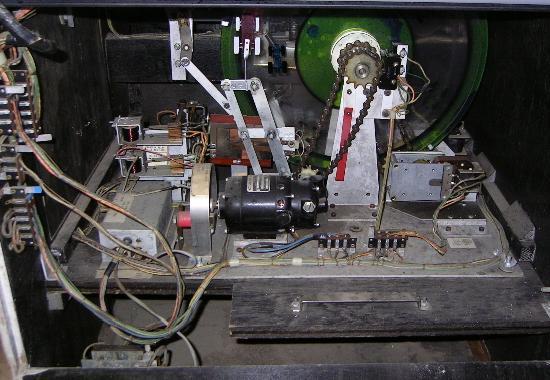
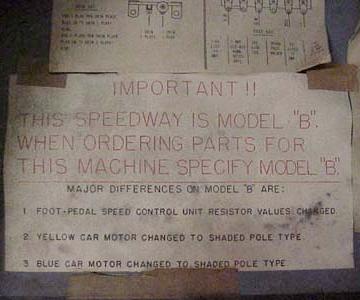
the "Mark III" version of Speedway (I'm not sure what is different, if anything):
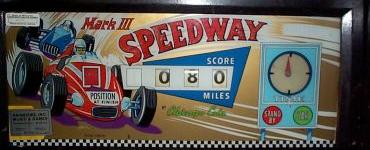
The car crash sound generator. Basically a piece of copper struck by a knocker coil,
and amplified by a photograph needle (damaged in this picture.) Notice the "LP" label,
because the needle is double sided (78 and LP records.)

Schematic for the sounds amplifier.

Here's the added MP3 player and bridge recifier and relay needed to
give the CCM Speedway the ambulance siren sound. I also added a small digital read-out so I can see
the 6vdc power.

|
* Email the collector cfh@provide.net * Go to the EM Arcade History index * Go to the Pinball Repair/History index |